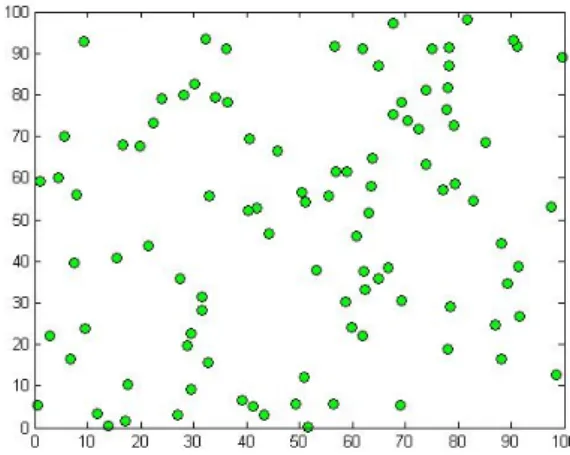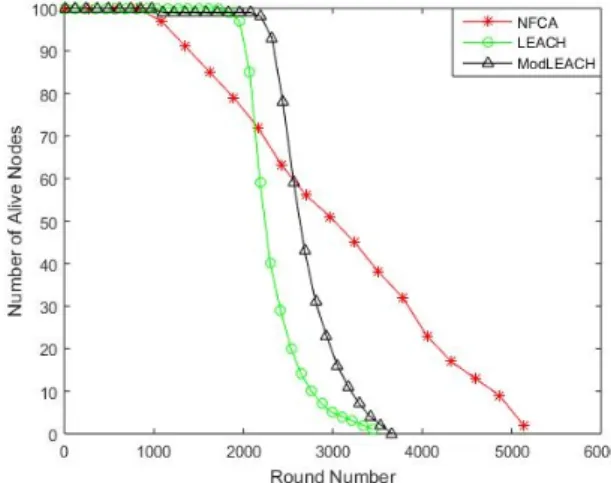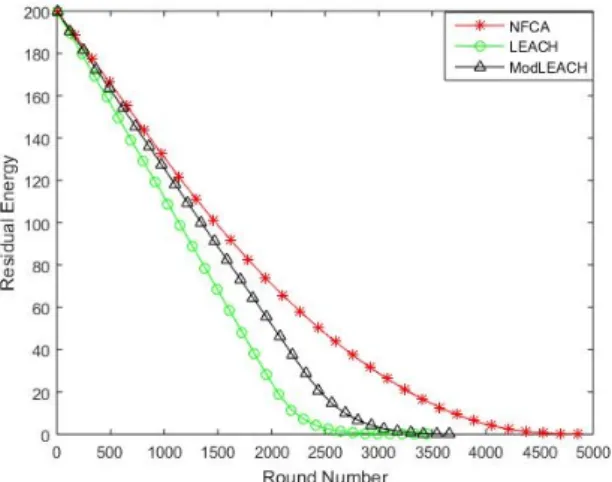Nearest Fixed Clustering Algorithm (NFCA) for
Wireless Sensor Networks
Korhan Cengiz
Department of Electrical-Electronics Engineering Trakya University, 22030
Edirne, Turkey korhancengiz@trakya.edu.tr
Tamer Dag
Department of Computer Engineering Kadir Has University, 34083
Istanbul, Turkey tamer.dag@khas.edu.tr Abstract— The objective of reducing energy consumption at
the sensor nodes has become a key research area for wireless sensor networks (WSNs) in recent years. With the steady increase in the cost of energy, the existing algorithms and protocols need to be redeveloped. In this paper, an energy-efficient routing protocol which forms fixed clusters is proposed. The new cluster head (CH) selections are made based on selecting nearest nodes to the current CH. The proposed protocol includes two phases to achieve the objective of energy-efficiency in WSNs. These phases are clustering phase where fixed clusters are established and CHs are determined randomly at the beginning and data transmission phase in which the collected information is transmitted to an outside base station (BS) and CH change occurs if needed. The results of the simulations of NFCA demonstrate that, NFCA outperforms LEACH and ModLEACH in terms of energy efficiency and lifetime.
Keywords— Energy-Efficient Routing; Fixed Clustering; Wireless Sensor Networks
I. INTRODUCTION
A WSN is formed by a collection of sensor nodes and corresponding protocols for routing messages in this network. A typical wireless sensor node consists of a sensory unit, a communication unit, a power unit and a processing unit. Sensory unit consists of a data acquisition component and ADC (converts the sensed real world data to the digital form). Communication unit has a radio transceiver and the power is backed by a battery source.
Limited energy availability in sensor nodes makes network lifetime an important issue in WSN applications. To prolong the network lifetime, energy efficient WSN clustering protocols and algorithms have been devised in the literature. The main goal of cluster-based routing protocol is to efficiently maintain the energy consumption of sensor nodes by involving them into a cluster and by performing data aggregation and fusion in order to decrease the number of transmitted messages to the BS and transmission distance of sensor nodes.
Low energy adaptive clustering hierarchy (LEACH) [1-2] is one of the most popular distributed cluster-based routing protocols in WSNs. In LEACH, clusters are formed randomly in an adaptive and self-organized way. The nodes in the network form clusters individually without any centralized control.
LEACH reduces the overall energy consumption of traditional communication protocols which are direct transmission where each sensor node sends its data directly to the BS, minimum transmission energy (MTE) which uses relay nodes between sensor nodes and BS. With LEACH, it is shown that, in direct transmission approach, if the BS is far away from nodes, direct transmission will require a large amount of transmit power from each node and in consequence, a large amount of energy dissipation. As a result, the battery of the nodes will be quickly drained and the number of dead nodes will increase thus the network lifetime will decrease. According to the analysis of LEACH, the node deaths are denser at further distances from the BS. When the MTE approach is analyzed, it is clearly shown that, relay or route nodes between sensor nodes and BS are also very energy harvesting nodes and this induces more energy dissipation and increases number of dead nodes which are located close to the BS.
In LEACH protocol, the time is divided into frames called as rounds. Each round consists of two phases. The first phase is set-up phase which includes cluster formation. The second phase is related to the normal function of the network and is called as steady-state phase. In the set-up phase, the CHs are elected based on a probability function. This election is as follows: each sensor node selects itself to become the CH at any given time with a certain probability. Every node in the network chooses a random number between 0 and 1. The chosen number for each node is compared with threshold limit, if the number is less than the threshold, the node becomes a CH for the current round. This probability function is designed in such a way that within a specific
number of rounds each sensor becomes a CH only once and thus the energy consumption is distributed over the whole network.
After the set up phase of a round,where the CHs are elected, each CH announces its election to other nodes and each node chooses a suitable (nearest) CH for itself; and then it announces this decision to the related CH. By this way, the clusters are formed and the network passes into the steady-state operation thus data transmission. Each CH creates a TDMA schedule in each cluster to organize the communication among cluster members. When the non CH nodes receive the TDMA schedule, nodes transmit their data to the CH once per frame during their allocated transmission of TDMA slots. This allows the radio components of each non CH node to put the sleep mode at all times except during its transmission time, thus minimizing the energy dissipated in the individual sensors. The CH collects all the transmitted data and send it to the BS. When a round is finished, the new round starts and the described process is repeated by re-electing CHs and forming new clusters. To prevent the interference of the transmissions which occur in different clusters at the same time, LEACH uses different CDMA codes. Existing CH chooses randomly a unique code from a list of spreading codes. The CH filters all received energy using this spreading code. Consequently, the radio signals of the neighboring nodes are filtered out hence interference of the transmission of the nodes is minimized.
In LEACH, the location information of the nodes are not known because it works based on a self-configuring network principle. The nodes are self-organized to perform related network tasks such as being CH, forming clusters, changing topology etc. At the beginning of the algorithm, all sensor nodes are CH candidates.
In some studies, authors have tried to improve the performance of LEACH. They have designed some protocols which made extensions to LEACH.
Modified LEACH (ModLEACH) [3] includes an efficient CH replacement scheme and dual transmitting power levels. The amplification energy is set to be the same for all kinds of transmissions in LEACH. But with ModLEACH, low energy level is used for intra cluster communications. Multi power levels are used to reduce the packet drop ratio, collisions and interference from other signals. When a node becomes a CH, the routing protocol in ModLEACH informs it to use high power amplification and when a node becomes a regular cluster member, the mode of that node becomes low level power amplification mode. Threshold based CH changing mechanism is used in ModLEACH to provide more efficient CH replacement. If the energy of the existing CH is higher than the threshold it continues to act as a CH if not a new CH for that cluster is elected and the cluster is formed again. Simulations of ModLEACH show that, ModLEACH
outperforms LEACH in terms of throughput, network lifetime and CH formation.
Power Efficient Gathering in Sensor Information Systems (PEGASIS) [4] is a chain-based protocol. In PEGASIS, each node transfers only with a close neighbor to direct and obtain information. It achieves approximately twice more energy saving when compared to LEACH.
Threshold Sensitive Energy-Efficient Sensor Network Protocol (TEEN) [5] is an event driven protocol. It uses a new concept to save power by transmitting sensed data only when some events happen like sudden increase in temperature etc. It is one of the most energy efficient protocol, but it cannot be applied to applications where periodic report of sensed data is needed to be passed to the sink because sensor nodes only switch on their communication module when some event occurs. It is also obtained from the literature that, TEEN outperforms LEACH in terms of energy efficiency.
In this paper, Nearest Fixed Clustering Algorithm (NFCA) is presented. It aims to use fixed clustering approach. It determines CHs randomly at the beginning of the algorithm. The formed clusters remain constant until the batteries of all sensor nodes are drained. The nearest CHs to the existing CHs are selected from alive members when a CH change is scheduled. The performance of NFCA algorithm is compared with LEACH and ModLEACH in terms of lifetime, residual energy and variation of number of clusters.
II. NFCAALGORITHM
At the beginning of NFCA algorithm, the sensor nodes are randomly deployed in a field as shown in Fig. 1. NFCA algorithm starts with the CH selection process. The CHs are selected randomly at the beginning of the algorithm. The clusters are formed only once in the clustering phase. The fixed clustering approach of NFCA provides for decreasing the networking and set-up costs of traditional clustering algorithms. The nodes in the network are static, thus transmission of position information is realized only once.
When the CHs are selected, they broadcast CH notification messages to the WSN. Each normal sensor node joins nearest cluster. After this joining process, the clusters are formed. In each cluster, CH is responsible for collecting data from its members. When data collection is finished, each CH transmits collected data to the BS which is placed outside of the sensor field. In NFCA, CH change is arranged by using a lower energy bound. If remaining energy of any CH falls down a lower bound, existing CH selects new CH from alive members in its cluster. This new selected member is the nearest member to the existing CH in that cluster which is shown in Fig. 2. Note that, for the simulations of NFCA, the lower bound is determined as the 1/8 of initial energy of a sensor node.
Fig. 2. An example for nearest CH selection in NFCA algorithm
III. SIMULATIONS OF NFCA
The simulations are conducted in MATLAB. 100 sensor nodes are randomly deployed in a 100 m x 100 m field as shown in Fig. 1 and BS is placed outside of the sensor field which have coordinates of (150,50). Same simulation parameters of LEACH [1-2] are used for all simulations in this paper. Each simulation is realized for 100 independent iterations to obtain more scalable results. Table I summarizes the simulation environment parameters used for simulations.
TABLE I. SIMULATION ENVIRONMENT PARAMETERS
Parameters Values
Network area 100 m x 100 m
Number of nodes 100
Base station coordinates (150,50) Initial energy per node 2 J Data packet size 6400 bits Control Packet Size 200 bits
Transceiver Energy (Eelec) 50 nJ/bit
Aggregation Energy per Bit (EDA) 5 nJ/bit/signal
Free Space Amplifier Energy (εfs) 10 pJ/bit/m2
Multipath Amplifier Energy (εmp) 0.0013 pJ/bit/m4
To obtain the optimum number of clusters value of NFCA, NFCA algorithm is evaluated for different number of clusters. Fig. 3 shows the results of this simulation. Note that, for LEACH the optimum number of clusters is 5% of the number of sensor nodes in WSN. For NFCA, it is obtained that this value is 10% of the number of sensor nodes in WSN.
Fig. 3. Average Lifetime of NFCA According to the Different Number of Clusters.
Fig. 4 shows the number of alive nodes thus the network lifetime for NFCA and other protocols. Under NFCA, the network lifetime increases from 3237 rounds to 5200 rounds, approximately 50% improvement compared to LEACH. Although, node deaths start earlier under NFCA, since the CHs are abused, the rate of the number of dead node increases is significantly less and this yields to a longer lifetime. One major difference between LEACH and NFCA can also be observed from this figure. Right after the first node death under LEACH, the remaining node deaths will follow quickly. But with NFCA, node deaths are distributed evenly for the network lifetime.
Fig. 5 illustrates the total residual energy of the nodes in terms of rounds. With fixed clustering, it can be observed that NFCA provides significant energy savings when compared to other protocols. After 2000 rounds, while LEACH holds 15% of its initial total energy, NFCA holds approximately 50% of its initial total energy. When the network lifetime ends under LEACH, NFCA still maintains approximately 20% of its total initial energy. NFCA also outperforms ModLEACH.
Fig. 5. Residual Energy of NFCA, LEACH and ModLEACH.
According to Fig. 6, fixed clustering nature of NFCA provides to collect information from WSN by using remaining clusters hence NFCA provides full network connectivity. On the other hand, LEACH based protocols cannot provide full network connectivity because there are cluster failures. This is the key strength property of NFCA algorithm. NFCA algorithm ensures full network connectivity when compared with LEACH based protocols.
Fig. 6. Variation of Number of Clusters of NFCA, LEACH and ModLEACH for Each Round.
IV. CONCLUSIONS AND FUTURE WORK
Enabling energy-efficiency [6, 7, 8], prolonging lifetime and promoting greening solutions [9] for WSNs has become an
essential research area. By using fixed number of clusters and decreasing the number of CH changes, NFCA minimizes the cluster formation overhead. The results of the simulations demonstrate that, proposed NFCA algorithm provides significant energy efficiency, lifetime gains when compared with LEACH and ModLEACH. Determining most appropriate CHs at the beginning of the algorithm can improve the performance of NFCA. Usage of relay nodes can also decrease the energy consumption of the farthest CHs to the BS. The utilization of relay nodes can provide energy-efficiency for NFCA.
REFERENCES
[1] W. Heinzelman, C. Anantha, and B. Hari, “Energy-efficient communication protocol for wireless microsensor networks,”, 33rd IEEE
annual Hawaii international conference on System sciences, Hawaii,
USA, 2000, pp. 1-10.
[2] W. Heinzelman, C. Anantha, and B. Hari, “An application-specific protocol architecture for wireless microsensor networks,” IEEE
Transactions on Wireless Communications, vol. 1, no. 4, pp. 660-670,
2004.
[3] Mahmood D, et al. “MODLEACH: A Variant of LEACH for WSNs,” IEEE International Conference on Broadband and Wireless
Computing, Communication and Applications (BWCCA), Compeigne,
FRANCE, 2013, pp. 158-163.
[4] S. Lindsey, C. S. Raghavendra, “Pegasis: Power-efficient gathering in sensor information systems,” IEEE International Aerospace Conference, Montana, USA, 2002, pp. 1125-1130.
[5] A. Manjeshwar, D. P. Agrawal, “Teen: a routing protocol for enhanced efficiency in wireless sensor networks,” IEEE International Symposium
on Parallel and Distributed Processing, San Francisco, USA, 2001, pp.
2009-2015.
[6] S. Saleh, M. Ahmed, et al, “A survey on energy awareness mechanisms in routing protocols for wireless sensor networks using optimization methods,” Transactions on Emerging Telecommunications Technologies vol. 25, no. 12, pp. 1184-1207, 2014.
[7] T. Dağ and K. Cengiz, “Towards Energy-Efficient MAC Protocols”, The
18th World Multi-Conference on Systematics, Cybernetics and
Informatics, Florida, USA, 2014.
[8] V. Mor and H. Kumar, “Energy efficient wireless mobile networks: A review,” IEEE International Conference on Optimization, Reliabilty,
and Information Technology (ICROIT), Haryana, India, 2014, pp.
281-285.
[9] K. Cengiz and T. Dağ, “A review on the recent energy-efficient approaches for the Internet protocol stack,” Eurasip Journal on Wireless
Communications and Networking, (2015):108, doi:


